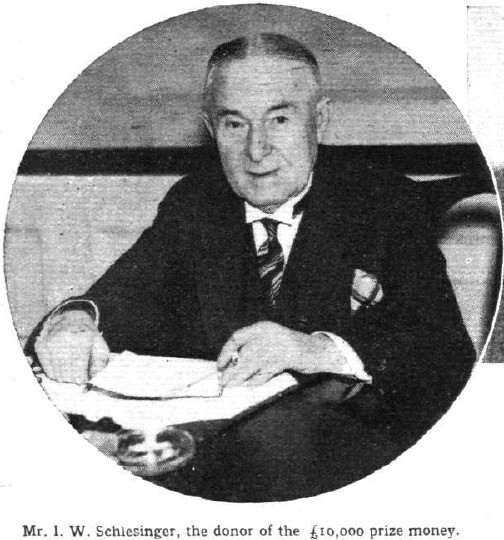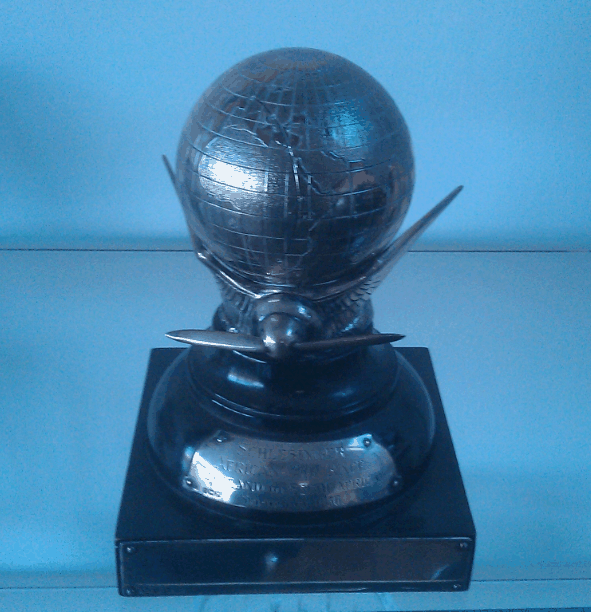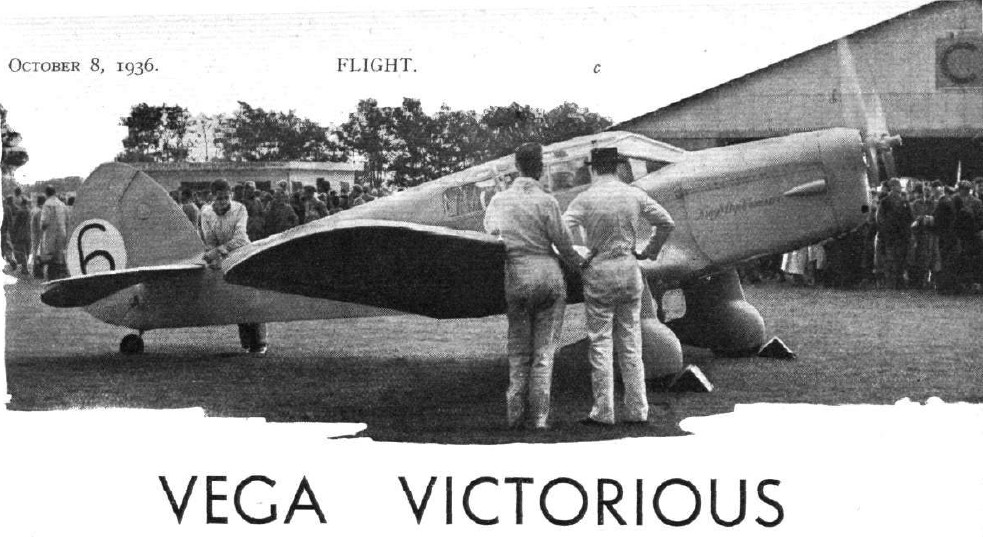Schlesinger Race on:
[Wikipedia]
[Google]
[Amazon]



 The Schlesinger Race, also known as the ''"Rand Race"'', the ''"Portsmouth – Johannesburg Race"'' or more commonly the 'African Air Race', took place in September 1936. The
The Schlesinger Race, also known as the ''"Rand Race"'', the ''"Portsmouth – Johannesburg Race"'' or more commonly the 'African Air Race', took place in September 1936. The


 Alington's and Booth's B.A. Eagle had a forced landing near Regensburg in Germany and damaged an undercarriage. A. Miller, flying
Alington's and Booth's B.A. Eagle had a forced landing near Regensburg in Germany and damaged an undercarriage. A. Miller, flying
British Pathe footage 1936 PORTSMOUTH – JOHANNESBURG AIR RACE
British Pathe footage 1936 PORTSMOUTH – JOHANNESBURG AIR RACE WELCOMED HOME
ITN Newsreel Race entrants and Aircraft 1936
ITN Newsreel of the race 1936
{{DEFAULTSORT:Schlesinger Race Air races 1936 in aviation 1936 in South Africa 1936 in Africa 1936 in South African sport



 The Schlesinger Race, also known as the ''"Rand Race"'', the ''"Portsmouth – Johannesburg Race"'' or more commonly the 'African Air Race', took place in September 1936. The
The Schlesinger Race, also known as the ''"Rand Race"'', the ''"Portsmouth – Johannesburg Race"'' or more commonly the 'African Air Race', took place in September 1936. The Royal Aero Club
The Royal Aero Club (RAeC) is the national co-ordinating body for air sport in the United Kingdom. It was founded in 1901 as the Aero Club of Great Britain, being granted the title of the "Royal Aero Club" in 1910.
History
The Aero Club was foun ...
announced the race on behalf of Isidore William Schlesinger who wanted to promote the Empire Exhibition, South Africa
The Empire Exhibition, South Africa, held in Johannesburg, was intended to mark that city's jubilee and was opened by the Governor-General of the Union of South Africa on 15 September 1936. It was the first exhibition held in the Union of South ...
and so offered a total of £10,000 in prize money to be divided into two sections, a speed race and a handicap race. The two sections were to be flown concurrently, but no competitor could win both first prizes.
The race was wholly inspired by the very successful 1934 MacRobertson Air Race
The MacRobertson Trophy Air Race (also known as the London to Melbourne Air Race) took place in October 1934 as part of the Melbourne Centenary celebrations. The race was devised by the Lord Mayor of Melbourne, Sir Harold Gengoult Smith, and th ...
to celebrate the centenary of the Australian state of Victoria. However, whilst that race was open to all-comers, Schlesinger made the fundamental error of restricting the entry of the Schlesinger Race to British Empire crews and machines only. This led directly to a much smaller entry and only one machine successfully completed the course after many aircraft either failed, crashed or given up. Magazines of the time, such as ''The Aeroplane'' and ''Flight'', were suitably scathing. MacRobertson Air Race winner C.W.A. Scott
Flight Lieutenant Charles William Anderson Scott, Air Force Cross (United Kingdom), AFC (13 February 1903 – 15 April 1946Dunnell ''Aeroplane'', November 2019, p. 46.) was an English aviator. He won the MacRobertson Air Race, a race from Londo ...
aided by Giles Guthrie
Sir Giles Connop McEachern Guthrie, 2nd Baronet, (21 March 1916 – 31 December 1979) was an English aviator, merchant banker and later, an airline industry executive, serving as the chairman and chief executive of the state owned airline Britis ...
won the race in a Percival Vega Gull, but it was a hollow victory, as most of the waiting spectators at Cape Town had given up and gone home by the time he arrived.
Race history
There were 14 entrants, but only nine aircraft took part in the race.Tom Campbell Black
Tom Campbell Black (December 1899 – 19 September 1936) was an English aviator.
He was the son of Alice Jean McCullough and Hugh Milner Black. He became a world-famous aviator when he and C. W. A. Scott won the London to Melbourne Centenary ...
was entered into the race in G-EAKL Percival Mew Gull
The Percival Mew Gull was a British racing aircraft of the 1930s. It was a small, single-engine, single-seat, low-wing monoplane of wooden construction, normally powered by a six-cylinder de Havilland Gipsy Six piston engine. During its racin ...
but ten days before the start of the race he was fatally injured at Speke Airport
Liverpool John Lennon Airport is an international airport in Liverpool, England, on the estuary of the River Mersey south-east of Liverpool city centre. Scheduled domestic, European, North African and Middle Eastern services are operated f ...
while preparing for the race when Flying Officer Peter Stanley Salter who was the Assistant Adjutant and Chief Flying Instructor of No. 611 Squadron taxied his Hawker Hart
The Hawker Hart is a British two-seater biplane light bomber aircraft that saw service with the Royal Air Force (RAF). It was designed during the 1920s by Sydney Camm and manufactured by Hawker Aircraft. The Hart was a prominent British aircra ...
No. K3044 into Black's aircraft which was also taxiing on the runway. Black's fuselage was almost cut in two when the Hart's propeller cut into it, mortally injuring Black, who died in the ambulance in the way to hospital. Two aircraft, Miles Peregrine and M. Chand's Percival Vega Gull
The Percival Vega Gull was a 1930s British, four-seater touring aircraft built by Percival Aircraft Limited. It was a single-engine, low-wing (Folding), wood-and-fabric monoplane with a fixed tailwheel undercarriage.
Design and development
...
were not ready, while John E. Carberry's Vega Gull was damaged when Beryl Markham landed in a peat bog at Balleine Cove, Cape Breton Island, after flying it across the Atlantic Ocean, 4–5 September.
The race began at Portsmouth aerodrome at 6.15 a.m. on Tuesday, 29 September. The winners of the race were C. W. A. Scott
Flight Lieutenant Charles William Anderson Scott, AFC (13 February 1903 – 15 April 1946Dunnell ''Aeroplane'', November 2019, p. 46.) was an English aviator. He won the MacRobertson Air Race, a race from London to Melbourne, in 1934, in a tim ...
and Giles Guthrie
Sir Giles Connop McEachern Guthrie, 2nd Baronet, (21 March 1916 – 31 December 1979) was an English aviator, merchant banker and later, an airline industry executive, serving as the chairman and chief executive of the state owned airline Britis ...
. Scott was famous for three England–Australia records and winning the MacRobertson Air Race
The MacRobertson Trophy Air Race (also known as the London to Melbourne Air Race) took place in October 1934 as part of the Melbourne Centenary celebrations. The race was devised by the Lord Mayor of Melbourne, Sir Harold Gengoult Smith, and th ...
with Tom Campell Black two years earlier. Scott and Guthrie were flying G-AEKE Percival Vega Gull
The Percival Vega Gull was a 1930s British, four-seater touring aircraft built by Percival Aircraft Limited. It was a single-engine, low-wing (Folding), wood-and-fabric monoplane with a fixed tailwheel undercarriage.
Design and development
...
entered by Giles' father Sir Connop Guthrie and they reached at Rand Airport
Rand Airport is an airport in Germiston, Gauteng, Germiston, South Africa. It was constructed in the 1920s as the main airport for Johannesburg
Johannesburg ( , , ; Zulu and xh, eGoli ), colloquially known as Jozi, Joburg, or "The City ...
on 1 October 1936. The aircraft had left Portsmouth 52 hours 56 minutes 48 seconds earlier. Out of the original 14 entries to the race Scott and Guthrie were the only ones to finish, winning the 10,000 pounds prize money.


 Alington's and Booth's B.A. Eagle had a forced landing near Regensburg in Germany and damaged an undercarriage. A. Miller, flying
Alington's and Booth's B.A. Eagle had a forced landing near Regensburg in Germany and damaged an undercarriage. A. Miller, flying Percival Mew Gull
The Percival Mew Gull was a British racing aircraft of the 1930s. It was a small, single-engine, single-seat, low-wing monoplane of wooden construction, normally powered by a six-cylinder de Havilland Gipsy Six piston engine. During its racin ...
, had a forced landing before Belgrade and withdrew. Next, T. Rose's B.A.4 Double Eagle got damaged on an airfield in Cairo, due to undercarriage folding. Victor Smith flying Miles Sparrowhawk had problems with oil since Salonika and eventually retired in Khartoum. On 30 September, S. Halse crashed his Percival Mew Gull
The Percival Mew Gull was a British racing aircraft of the 1930s. It was a small, single-engine, single-seat, low-wing monoplane of wooden construction, normally powered by a six-cylinder de Havilland Gipsy Six piston engine. During its racin ...
in a forced landing 20 miles before Salisbury
Salisbury ( ) is a cathedral city in Wiltshire, England with a population of 41,820, at the confluence of the rivers Avon, Nadder and Bourne. The city is approximately from Southampton and from Bath.
Salisbury is in the southeast of ...
. D. Llewellyn and C. Hughesdon in Percival Vega Gull
The Percival Vega Gull was a 1930s British, four-seater touring aircraft built by Percival Aircraft Limited. It was a single-engine, low-wing (Folding), wood-and-fabric monoplane with a fixed tailwheel undercarriage.
Design and development
...
had a forced landing before Abercorn (today's Mbala), on a shore of Lake Tanganika
Lake Tanganyika () is an African Great Lake. It is the second-oldest freshwater lake in the world, the second-largest by volume, and the second-deepest, in all cases after Lake Baikal in Siberia. It is the world's longest freshwater lake. T ...
. In a difficult weather conditions, the Airspeed Envoy crashed during a take off from Abercorn, killing the pilot Maxwell Findlay and radio operator A. Morgan, while Kenneth Waller and the passenger Derek Peachey escaped with injuries. Finally, A.E. Clouston made a forced crash landing 150 miles south of Salisbury in his Miles Hawk Six.
In 1937 Charles E. Gardner went on to win the King's Cup Race
The King's Cup air race is a British handicapped cross-country event, which has taken place annually since 1922. It is run by the Royal Aero Club Records Racing and Rally Association.
The King's Cup is one of the most prestigious prizes of the ...
in the repaired Mew Gull G-AEKL in which Black had suffered his fatal accident. Guthrie also flew in this race in Vega Gull G-AFAU, finishing in fifth place.
Due to the fact that only one entrant finished the race, Schlesinger suggested that the finishers money which would remain unclaimed should be paid to the dependants of Findlay and Morgan, who met with a fatal accident in the race.
List of entrants
References
;NotesExternal links
* *Films and newsreel footage
British Pathe footage 1936 PORTSMOUTH – JOHANNESBURG AIR RACE
British Pathe footage 1936 PORTSMOUTH – JOHANNESBURG AIR RACE WELCOMED HOME
ITN Newsreel Race entrants and Aircraft 1936
ITN Newsreel of the race 1936
{{DEFAULTSORT:Schlesinger Race Air races 1936 in aviation 1936 in South Africa 1936 in Africa 1936 in South African sport